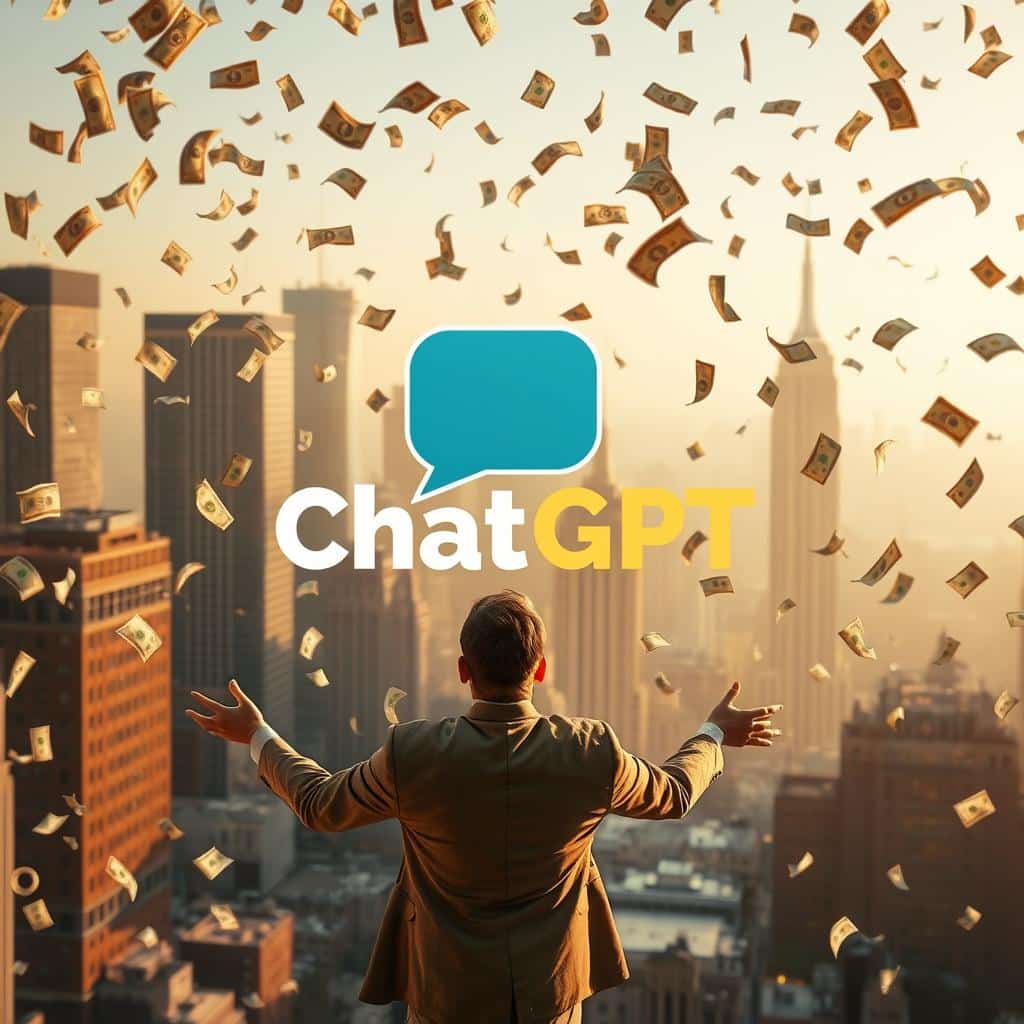I frame this guide around real U.S. conditions. Living costs are rising, and more people seek flexible ways to add income without a second full-time job. I focus on clear, practical steps that cut through hype and show replicable paths.
My approach treats AI as an efficiency multiplier — never a substitute for judgement. I pair tested ideas with validation, sharp positioning, and an execution plan. That way I avoid guessing in a crowded market.
I map a simple progression: beginner services, scalable digital products, and subscription models that build monthly recurring revenue. I pick ideas that solve pain points, meet recurring needs, or fix time-sensitive problems that translate into predictable revenue.
Key Takeaways
- I offer practical ways to turn skills into short-term income and longer-term assets.
- My strategy blends validation, clear positioning, and execution steps.
- I prioritize predictable revenue over one-off payouts.
- Tools like AI speed research and content work, while human judgment remains central.
- The playbook covers services, digital products, subscriptions, and a one-week action plan.
Why I’m Using AI Right Now to Boost Income in the United States
Right now I use AI to rapidly compress tasks so I can focus on higher-value client work. More than a third of people in the U.S. have tried chatgpt since 2022, and that adoption shows why this model matters for side work.
I use the tool to cut research and drafting time so I can spend time on sales, positioning, and delivery. This way I ship more consistent services while keeping quality high.
Practical wins:
- I brief, outline, and do first-pass drafts with chatgpt, then edit for U.S.-specific tone and facts.
- I test offers fast—mockups, landing copy, outreach—so the market validates a model before I invest hours.
- I balance quick-turn gigs with assets that compound, protecting my income from being only billable work.
| Metric | Typical U.S. Rate | How I Apply It |
|---|---|---|
| VA Hourly | $27.15 | Template scheduling + copy drafts to reduce admin time |
| Tutoring Range | $10–$150+ | Create study guides and quizzes for faster prep |
| Adoption | 34% of Americans | Use signals to pick services and social media offers |
Beginner-Friendly Ways I Make Money Using ChatGPT
I begin with straightforward offers that require low setup and clear outcomes for clients.

Tutoring with AI-Generated Study Guides
I use AI to draft practice problems and templates, then I customize by grade and verify facts. Tutors can charge $10–$150+ per hour depending on subject and experience.
Virtual Assistant Services
I draft emails, meeting notes, and simple SOPs quickly. At typical VA rates near $27.15/hour, I manage calendars and content schedules so clients get reliable support.
Content Writing, Social Media, and Translation
I treat the tool as a first-draft engine for content writing. I add original examples, localize for U.S. readers, and follow client policies that limit AI-only work.
For social media, I deliver caption packs, hashtag sets, and weekly calendars. For translation, I use quick passes for terminology, then apply my fluency to fix tone and idioms.
Starter rules I follow:
- Keep scope tight: single module or 10-caption pack.
- Fact-check all AI drafts to avoid hallucinations.
- Price transparently, then scale to retainers after proof.
| Service | Typical Rate | How I Deliver |
|---|---|---|
| Tutoring | $10–$150+/hr | Custom study guides, verified content |
| Virtual Assistant | $27.15/hr | Emails, calendars, SOPs |
| Social Media | Package pricing | Captions, calendars, hashtag sets |
| Translation | Per-word or hourly | AI first pass, human review |
Digital Products That Sell While I Sleep
I build small, focused products that match clear buyer needs on popular platforms. My goal is steady revenue with low upkeep.

Etsy-Ready Printables: Planners, Trackers, and Guides
Printable planners, habit trackers, and guides are fast to produce and simple to deliver. About 38% of Etsy sellers began to supplement income this way, and many report steady returns.
Quick wins: niche research, seasonal tags, and standardized colorways raise order value without extra time. Bundles convert better than single files.
My Workflow: From Ideation to Upload Using Tools Like ChatGPT
I follow a lightweight production line: scan competitor listings, brainstorm ideas, then draft outlines and layouts. I check fonts and graphics for licensing to stay compliant.
- I use AI to draft titles, descriptions, and benefit bullets for platforms such as Etsy and Gumroad, then refine for keywords and clarity.
- I test tiered pricing and watch real sales data, adjusting offers by conversion rather than guesswork.
- I document each step so I can scale or hand off work later while keeping consistent content quality.
Online Courses and Workshops I Build with ChatGPT
I create compact workshops that turn knowledge into repeatable steps for students. I validate topics by collecting FAQs, studying competitor curricula, and clustering themes into a clear learning path that solves a defined problem.

Outlines, Lesson Scripts, and Workbooks That Convert
I start with an AI-first draft for an outline, then I refine modules and add U.S.-specific examples. I script lessons in my voice so learners connect quickly.
Workbooks and checklists turn concepts into action. AI drafts frameworks; I convert them into fillable resources to raise completion rates.
Choosing Platforms and Pricing Models for Steady Revenue
I pick platforms like Teachable or Thinkific for built-in checkout, analytics, and delivery. I test models—one-time, cohort, subscription—and bundle templates or swipe files to boost perceived value.
“I run a live beta, collect feedback, then build an evergreen funnel so the course pays after launch.”
- I plan promo posts, short livestreams, and email sequences focused on outcomes.
- I track enrollments, completion rates, and refunds to iterate quickly.
| Stage | Action | Why it matters |
|---|---|---|
| Validate | Collect FAQs, competitor analysis | Ensures market fit |
| Create | AI-first outline, script lessons | Saves time, preserves my voice |
| Sell | Teachable/Thinkific, tiered pricing | Reliable checkout + steady revenue |
Growing a YouTube Channel with AI Help
I treat each clip as part of a larger media funnel that pushes viewers deeper. This makes it easier to plan content that builds session time and keeps discovery steady.

Script ideation, titles, and descriptions that drive clicks: I use tools for rapid script outlines, then write sharp openers and title options that boost click-through. I draft descriptions with chapter markers and CTAs to increase watch-time.
- Formats: repeatable series like “AI in 5 minutes” or case-study posts make production faster.
- Metadata: I A/B test thumbnails and refine titles to improve suggested traffic.
- Repurposing: short posts and email snippets extend reach across platforms.
Monetization Requirements: Partner Program Eligibility
The Partner Program requires 1,000 subscribers and 4,000 public watch hours in the last 12 months, or 10 million valid Shorts views in 90 days. Once approved, I can use ads, memberships, and channel features to monetize.
| Focus | What I Track | Why it matters |
|---|---|---|
| Acquisition | Subscribers, CTR | Growth and eligibility |
| Engagement | Average view duration | Suggested traffic and retention |
| Output | Upload cadence | Algorithm signals and audience habit |
“I monitor CTR, average view duration, and retention to iterate creative choices and build steady channel growth.”
Turning Side Gigs into Monthly Recurring Revenue
I turned sporadic gigs into steady subscriptions by redesigning each offer around a monthly outcome. This shift made planning simpler and gave me clearer ARR visibility.

From One-Off Projects to Subscriptions: My Business Model Shift
I moved from single projects to monthly lines that clients can renew easily. I package repeatable deliverables so delivery stays efficient and value is obvious.
Retention Offers: Newsletters, Communities, and CaaS
I sell paid newsletters, membership communities, and Content-as-a-Service bundles like monthly SEO calendars or Instagram packs. These offers meet recurring needs and cut churn when outcomes are clear.
Five Prompts I Use to Design MRR Offers with the tool
- Find niche pain points and product ideas.
- Title and tier a paid newsletter.
- Generate a monthly product pack template.
- Define deliverables for a $99/month service.
- Draft a retainer pitch email that converts clients.
Pricing, Add-Ons, and Predictable ARR for Better Planning
I keep a simple base plan and layer add-ons like priority support or private sessions. I track churn, ARPU, and expansion revenue to tune pricing.
| Tier | Example | Monthly |
|---|---|---|
| Bronze | Newsletter | $10 |
| Pro | Monthly content pack | $99 |
| Agency | Retainer | $500+ |
Chat GPT and Money Earning: My Strategy, Tools, and Ethics
I treat AI as an accelerator, not a replacement, and I build clear guardrails so speed does not erode quality. The goal is to free time for strategy, original analysis, and client relationships while protecting legal and ethical standards.

Working Smarter: Time Savings, Idea Generation, and Research
The tool can save hundreds of hours a year by handling first-pass research and outline drafting. I use it to pull topic clusters, summarize sources, and test angle ideas fast.
That said, I always verify data, names, and statistics. When deeper research is needed, I slow down and add primary sources rather than ship shallow content.
Quality, Copyright, and Transparency When Using AI
Copyright and originality matter. AI-only output lacks protected authorship, so I add original examples, structural changes, and analysis to meet copyright thresholds.
- I keep a prompt library, style guide, and fact-check checklist so my writing stays consistent and accurate.
- I disclose using chatgpt where client rules require it and ensure final deliverables are human-edited.
- I avoid overreliance: regular quality reviews catch tone drift, plagiarism risks, and weak arguments.
“I balance speed with depth: plan, draft, fact-check, edit, polish, and final review.”
Following these rules helps me use the tool as a true strategy enabler while keeping clients and people who rely on my work confident in the result.
Advanced Opportunities I Explore with ChatGPT
My focus shifts to projects that combine research, product design, and measurable marketing outcomes. These offers move past one-offs and become repeatable systems for clients and for my own business.

Keyword Research and SEO Content Packages for Clients
I sell SEO packages that include topic clusters, outlines, and briefs. I use chatgpt help to speed ideation, then verify terms with SEO tools before delivery.
Each package maps content to buyer intent so businesses see clearer ranking paths and faster wins.
Faceless Channels, Product Descriptions, and Link Outreach
I script faceless video formats where AI drafts the base script and I focus on pacing, edits, and thumbnails for higher CTR.
I also generate product descriptions at scale, keeping voice consistent and conversion-focused without keyword stuffing.
For outreach, I identify targets, draft personalized pitches, and track replies so link building stays authentic and measurable.
Prototyping Chrome Extensions and Simple AI Tools
I prototype small extensions and utility tools by using AI for code snippets and debugging guidance. Then I validate demand with tiny pilots or preorders.
Why this matters: prototyping product features turns services into assets that sell repeatedly and justify higher retainers.
“I package skills into repeatable systems—SEO calendars, on-page updates, and dashboards—so clients see a path from content to results.”
Outcomes I track: rankings, traffic, CTR, and conversion lift. These numbers turn advanced services into clear business cases for retainer work.
My One-Week Action Plan to Launch or Level Up
I set a tight, seven-day plan that turns a single skill into a launch-ready offer. This keeps me focused and saves time while I test demand.

Day 1: I pick a niche and define one problem worth solving. I write a one-sentence promise and list three outcomes clients will get.
Day 2: I choose a delivery format—mini service, productized pack, or subscription—and draft scope, timeline, and a simple pricing tier.
Day 3: I use AI to draft landing copy, a short FAQ, and 3–5 social posts. I refine language and add proof points so ideas land with my audience.
Day 4: I set up platforms: payment link, booking calendar, and a lightweight onboarding form so I can accept clients immediately.
Day 5: I build a minimal portfolio sample or a one-page case study that shows a clear before/after transformation.
Day 6: I prospect 20 targets with personalized outreach, track responses, and refine my pitch.
Day 7: I deliver for early adopters, collect testimonials, and decide whether to lock in retainers or keep testing.
“Pick one path and execute cleanly; simplicity scales better than scattered effort.”
I automate intake, confirmations, and file delivery so I protect my work time. I set a weekly review ritual to track leads, close rate, delivery time, and client satisfaction. These small habits form a practical strategy for side ways to make money fast without overwhelm.
Conclusion
I close by urging a focused, single experiment that proves what works fast. Start small to build income and test real demand. Pick one of the ways I described—service, product, or subscription—and ship.
I use chatgpt to speed drafts, but I rely on my research, original writing, and quality checks to keep clients. Validate ideas with quick tests, track data, and refine your niche.
Remember platform realities: video channels need thresholds for ads, and subscriptions bring steady revenue more often than one-off gigs. Treat the tool as leverage; disciplined work and clear positioning make a business durable.
Pick one action this week, deliver value, then iterate. Momentum beats perfection.
